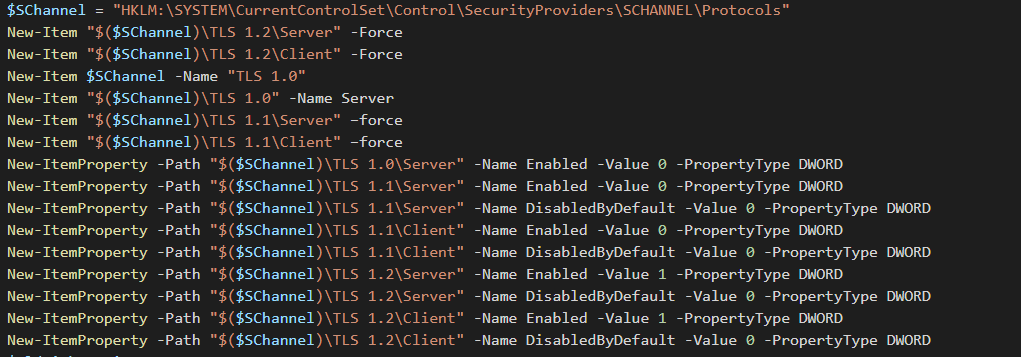I always like getting the maximum achievable rank on websites such as SSLLabs, or the Microsoft Secure Score, because I know I’ve done all that a manufacturer says I need to do to protect their product. The SSL cipher suites are one of these things.
You can run the following script on both Windows Servers that are running IIS to achieve a SSLLabs A rank, but also you can run this script on client machines to increase the security so they will not use older ciphers when requested.
The monitoring script
Monitoring the cipher suites is fairly straightforward. First we’ll check if TLS1.0 and TLS1.1 are disabled and if TLS1.2 is enabled, After that, we check if old know “bad” ciphers are no longer used.
1
2
3
4
5
6
7
8
9
10
11
12
13
14
15
16
17
18
19
20
21
22
23
24
25
26
27
28
29
30
31
32
33
34
35
36
37
38
39
40
41
42
43
44
45
46
47
48
49
|
$SChannel = "HKLM:\SYSTEM\CurrentControlSet\Control\SecurityProviders\SCHANNEL\Protocols"
$TLS1ServerEnabled = Get-ItemProperty -Path "$($SChannel)\TLS 1.0\Server" -Name Enabled -ErrorAction SilentlyContinue
$TLS11ServerEnabled = Get-ItemProperty -Path "$($SChannel)\TLS 1.1\Server" -Name Enabled -ErrorAction SilentlyContinue
$TLS11ClientEnabled = get-ItemProperty -Path "$($SChannel)\TLS 1.1\Client" -Name Enabled -ErrorAction SilentlyContinue
$TLS12ServerEnabled = get-ItemProperty -Path "$($SChannel)\TLS 1.2\Server" -Name Enabled -ErrorAction SilentlyContinue
$TLS12ClientEnabled = get-ItemProperty -Path "$($SChannel)\TLS 1.2\Client" -Name Enabled -ErrorAction SilentlyContinue
If(!$TLS1ServerEnabled -or $TLS1ServerEnabled -eq 1) { $TLS1ServerEnabled = "TLS Server 1.0 could be enabled. Please investigate" } else { $TLS1ServerEnabled = "Healthy" }
If(!$TLS11ServerEnabled -or $TLS11ServerEnabled -eq 1) { $TLS11ServerEnabled = "TLS Server 1.1 could be enabled. Please investigate" } else { $TLS11ServerEnabled = "Healthy" }
If(!$TLS11ClientEnabled -or $TLS11ClientEnabled -eq 1) { $TLS11ClientEnabled = "TLS Client 1.1 could be enabled.. Please investigate" } else { $TLS11ClientEnabled = "Healthy" }
If(!$TLS12ServerEnabled -or $TLS12ServerEnabled -eq 0) { $TLS12ServerEnabled = "TLS Server 1.2 could be disabled. Please investigate" } else { $TLS12ServerEnabled = "Healthy" }
If(!$TLS12ClientEnabled -or $TLS12ClientEnabled -eq 0) { $TLS12ClientEnabled = "TLS Client 1.2 could be disabled Please investigate" } else { $TLS12ClientEnabled = "Healthy" }
$OldCipherSuites =
@(
"TLS_DHE_RSA_WITH_AES_256_CBC_SHA"
"TLS_DHE_RSA_WITH_AES_128_CBC_SHA"
"TLS_RSA_WITH_AES_256_GCM_SHA384"
"TLS_RSA_WITH_AES_128_GCM_SHA256"
"TLS_RSA_WITH_AES_256_CBC_SHA256"
"TLS_RSA_WITH_AES_128_CBC_SHA256"
"TLS_RSA_WITH_AES_256_CBC_SHA"
"TLS_RSA_WITH_AES_128_CBC_SHA"
"TLS_RSA_WITH_3DES_EDE_CBC_SHA"
"TLS_DHE_DSS_WITH_AES_256_CBC_SHA256"
"TLS_DHE_DSS_WITH_AES_128_CBC_SHA256"
"TLS_DHE_DSS_WITH_AES_256_CBC_SHA"
"TLS_DHE_DSS_WITH_AES_128_CBC_SHA"
"TLS_DHE_DSS_WITH_3DES_EDE_CBC_SHA"
"TLS_RSA_WITH_RC4_128_SHA"
"TLS_RSA_WITH_RC4_128_MD5"
"TLS_RSA_WITH_NULL_SHA256"
"TLS_RSA_WITH_NULL_SHA"
"TLS_PSK_WITH_AES_256_GCM_SHA384"
"TLS_PSK_WITH_AES_128_GCM_SHA256"
"TLS_PSK_WITH_AES_256_CBC_SHA384"
"TLS_PSK_WITH_AES_128_CBC_SHA256"
"TLS_PSK_WITH_NULL_SHA384"
"TLS_PSK_WITH_NULL_SHA256"
)
$SuitesEnabled = @()
foreach($Suite in $OldCipherSuites){
$SuitesEnabled += get-TlsCipherSuite -name $Suite
}
if(!$SuitesEnabled){
$SuitesEnabled = "Healthy. No old cipher suites found"
} else {
$SuitesEnabled = "Possible old cipher suites found"
}
|
After you run this script, you can alert on the contents of $SuitesEnabled to see if old cipher suites are enabled. You also should alert on the content of the following five variables to make sure that you have them all in a “Healthy” state
1
2
3
4
5
|
$TLS1ServerEnabled
$TLS11ServerEnabled
$TLS11ClientEnabled
$TLS12ServerEnabled
$TLS12ClientEnabled
|
the remediation is actually very similar to the script above, but we change to create the registry keys this time, and to disable the cipher suites using disable-Tlsciphersuite.
1
2
3
4
5
6
7
8
9
10
11
12
13
14
15
16
17
18
19
20
21
22
23
24
25
26
27
28
29
30
31
32
33
34
35
36
37
38
39
40
41
42
43
44
45
46
|
$SChannel = "HKLM:\SYSTEM\CurrentControlSet\Control\SecurityProviders\SCHANNEL\Protocols"
New-Item "$($SChannel)\TLS 1.2\Server" -Force
New-Item "$($SChannel)\TLS 1.2\Client" -Force
New-Item $SChannel -Name "TLS 1.0"
New-Item "$($SChannel)\TLS 1.0" -Name Server
New-Item "$($SChannel)\TLS 1.1\Server" –force
New-Item "$($SChannel)\TLS 1.1\Client" –force
New-ItemProperty -Path "$($SChannel)\TLS 1.0\Server" -Name Enabled -Value 0 -PropertyType DWORD
New-ItemProperty -Path "$($SChannel)\TLS 1.1\Server" -Name Enabled -Value 0 -PropertyType DWORD
New-ItemProperty -Path "$($SChannel)\TLS 1.1\Server" -Name DisabledByDefault -Value 0 -PropertyType DWORD
New-ItemProperty -Path "$($SChannel)\TLS 1.1\Client" -Name Enabled -Value 0 -PropertyType DWORD
New-ItemProperty -Path "$($SChannel)\TLS 1.1\Client" -Name DisabledByDefault -Value 0 -PropertyType DWORD
New-ItemProperty -Path "$($SChannel)\TLS 1.2\Server" -Name Enabled -Value 1 -PropertyType DWORD
New-ItemProperty -Path "$($SChannel)\TLS 1.2\Server" -Name DisabledByDefault -Value 0 -PropertyType DWORD
New-ItemProperty -Path "$($SChannel)\TLS 1.2\Client" -Name Enabled -Value 1 -PropertyType DWORD
New-ItemProperty -Path "$($SChannel)\TLS 1.2\Client" -Name DisabledByDefault -Value 0 -PropertyType DWORD
$OldCipherSuites =
@(
"TLS_DHE_RSA_WITH_AES_256_CBC_SHA"
"TLS_DHE_RSA_WITH_AES_128_CBC_SHA"
"TLS_RSA_WITH_AES_256_GCM_SHA384"
"TLS_RSA_WITH_AES_128_GCM_SHA256"
"TLS_RSA_WITH_AES_256_CBC_SHA256"
"TLS_RSA_WITH_AES_128_CBC_SHA256"
"TLS_RSA_WITH_AES_256_CBC_SHA"
"TLS_RSA_WITH_AES_128_CBC_SHA"
"TLS_RSA_WITH_3DES_EDE_CBC_SHA"
"TLS_DHE_DSS_WITH_AES_256_CBC_SHA256"
"TLS_DHE_DSS_WITH_AES_128_CBC_SHA256"
"TLS_DHE_DSS_WITH_AES_256_CBC_SHA"
"TLS_DHE_DSS_WITH_AES_128_CBC_SHA"
"TLS_DHE_DSS_WITH_3DES_EDE_CBC_SHA"
"TLS_RSA_WITH_RC4_128_SHA"
"TLS_RSA_WITH_RC4_128_MD5"
"TLS_RSA_WITH_NULL_SHA256"
"TLS_RSA_WITH_NULL_SHA"
"TLS_PSK_WITH_AES_256_GCM_SHA384"
"TLS_PSK_WITH_AES_128_GCM_SHA256"
"TLS_PSK_WITH_AES_256_CBC_SHA384"
"TLS_PSK_WITH_AES_128_CBC_SHA256"
"TLS_PSK_WITH_NULL_SHA384"
"TLS_PSK_WITH_NULL_SHA256"
)
foreach($Suite in $OldCipherSuites){
disable-TlsCipherSuite -name $Suite -ErrorAction SilentlyContinue
}
|
And that’s it! I hope you’ve enjoyed and as always, Happy PowerShelling
